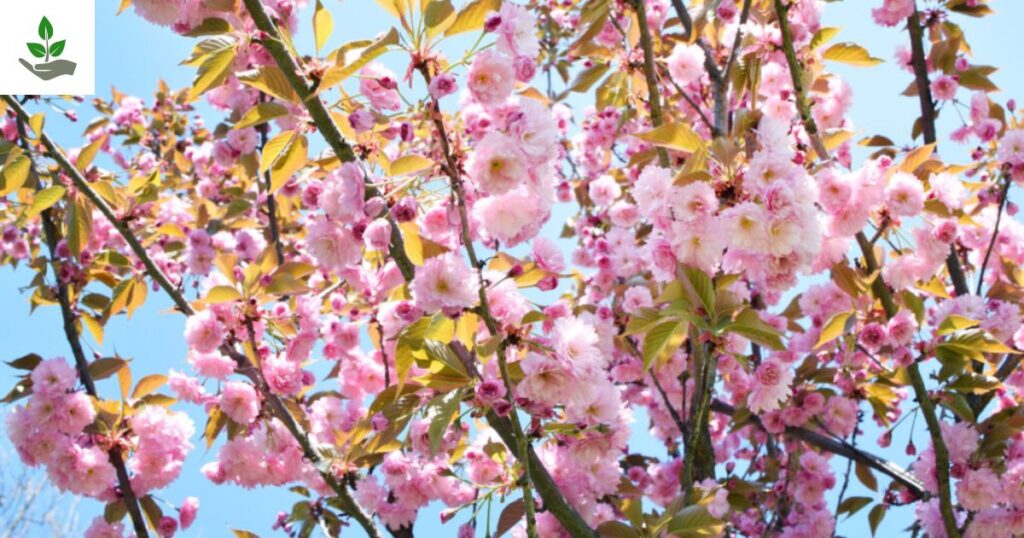Kwanzan Cherry Tree: Essential Guide to Growing & Care
Few spring vistas are lovelier than the dazzling sight of a Kwanzan cherry tree in bloom. These beautiful landscape trees cause worlds to turn over with their burst of double pink blooms, producing a show-stopping canopy that beckons sightseers.
The Kwanzan cherry (Prunus serrulata Kwanzan) will have to be given some thought. Native to Japan but now also a sensation everywhere in the world, Kwanzan cherry are giving stunning flowering with tight growth and no maintenance needs. We have covered everything that you need to know on how to select, plant, and care for these lovely flowering trees.
What Is The Kwanzan Cherry Tree?
The Kwanzan cherry Prunus serrulata Kwanzan is regarded to be one of the most exquisite spring garden ornamental flowering trees. The deciduous tree that has its origin in China, Korea, and Japan is enjoyed for its marvelous double-petaled large pink flowers that occur in pendulous clusters in mid to late spring.
Reaching medium size of 15-25 feet with matching spread, the Kwanzan has vase-shaped to rounded crown with striking dark bark and horizontal lenticels. Following flowering, its new leaves are serrated, bronze and turn deep green in summer before coppery-orange to bronze in autumn.

Especially prized for formal gardens and parks, as well as for street planting, the Kwanzan cherry has a shorter life (15-25 years) than some, but has an unbeatable appearance value in the height of bloom, living up to its place as one of the most popular varieties of flowering cherry trees within Japan and as a symbol in Japanese culture for transience of beauty.
Kwanzan Cherry History
The Kwanzan cherry is deeply rooted in the culture of East Asia. Having its origins in China, Korea, and Japan, the flower cherry type is one of the species of the Japanese flowering cherry tree (Prunus serrulata) and was chosen for centuries by breeding as gardening technology developed.
The “Kwanzan” spelled also as Kanzan derives its name from a Chinese sacred mountain, referring to its origins being Eastern. It was equally greatly valued in Japan where the cherry tree (sakana) has been valued at least since the 8th century with the specific mention of cultivated forms appearing in Heian period texts (794-1185 CE).
What Are Kwanzan Cherry Seeds?
Kwanzan cherry present an interesting botanical peculiarity when it comes to their Kwanzan cherry show a striking botanical anomaly in regard to seeds. Unlike most flowering trees, Kwanzan cherry trees (Prunus serrulata ‘Kwanzan’) are sterile and never yield fertile seeds or fruits.
This characteristic is also very much in line with their extremely ornamental quality – the energy of the tree is used to produce only the double pink flowers and not in creating fruits and seeds.
Kwanzan Cherry Planting And Growing
How to grow and maintain a Kwanzan cherry tree successfully involves the observance of certain growing conditions and care procedures. The showy trees have USDA hardiness zones of 5-9 and will perform best if grown in full sun (a minimum of 6 hours of direct sunlight each day), but also partial shade will be acceptable.
The preferred soil for Kwanzan cherries is moderately fertile, slightly acidic to neutral (pH 6.0-7.0), and well-draining. Organic matter like compost should be incorporated into the soil prior to planting to enhance drainage and soil structure since these trees are very prone to root rot in wet soils.
Autumn and spring are the ideal times to plant, and still better in early spring in colder regions so roots have time to establish themselves before winter. Plant by digging a hole twice as wide as the root ball but the same depth, since planting too deeply stresses the tree.

After planting the tree, fill with soil local to the area, install a water basin surrounding the trunk, mulch up to 2-3 inches (leave at least several inches of clearance between the trunk and the mulch) and thoroughly water.
In the establishment phase of approximately two years, frequent moisture is desirable, and deep watering once a week during dry periods is suggested. Young trees also respond favorably to an annual application of balanced, slow-release fertilizer in early spring before leaf break.
Pruning has to be minimal and carried out shortly after flowering to avoid the excision of next year’s flower buds, and primarily consist of the elimination of dead, infected, or crossing branches in order to maintain the natural vase-shape form of the tree.
Be on the lookout for common pests and diseases like aphids, borers, and fungal infections like leaf spot and powdery mildew. With proper care, these 15-25 year lived medium-lived trees will treat you to fabulous spring extravagacies of cascading trusses of double-pink flowers that make them among the most handsome ornamental trees in temperate gardens.
Kwanzan Cherry Care
Maintaining Kwanzan cherry trees correctly starts with correct watering methods. The first two years after planting require continuously damp but not soggy soil, generally needing to be deeply watered once weekly when there is no rain.
These trees, once planted, are a bit drought tolerant, though added water during very dry spells is always appreciated. Water at the drip line and not on the trunk to promote outward root growth and reduce possible disease.
Fertilize with caution, as over-fertilization will encourage greater vegetative growth than flowering. Use a slow-release, balanced fertilizer in the form of 10-10-10 NPK in early spring when new growth has not yet occurred.
Once annually, fertilize in mature trees; in younger trees, a half-strength application in early summer may be of some benefit. Soil testing may indicate particular nutrient deficiencies in which particular amendments are indicated.
Mulch is an important part of Kwanzan cherry care since it helps retain moisture, prevents weeds, and modulates soil temperature. Have a 2-3 inch layer of organic mulch like shredded wood or bark chips in a radius around the drip line, always a few inches from the trunk to avoid bark rot due to moisture and rodent invasion.

Minimal and judicious pruning only. Prune in flowering season shortly after it has ceased because Kwanzan cherries flower on older wood, and pruning in late season will cut off flower buds for the following year.
Target pruning at removing dead, diseased, or damaged wood and crossing branches which rub against one another. Preserve the natural vase-shaped shape of the tree instead of trying heavy structural changes.
Continuous monitoring for frequent pest problems such as aphids, scale, and borers will permit early intervention. Monitoring for disease is also critical with special attention being given to bacterial canker, leaf spot, and powdery mildew.
Good cultural practices such as air circulation, avoiding overhead watering, and speedy clearing of dropped leaves can make a significant reduction in disease pressure and assist in keeping these magnificent flowering trees in good health and radiant-looking in appearance.
Kwanzan Cherry Uses And Benefits
- Ornamental Value: Provides spectacular spring displays of large, double pink blossoms that create visual impact in landscapes
- Urban Landscaping: Well-suited for street plantings and urban settings due to its compact size and absence of messy fruits
- Shade Provision: Offers moderate shade with its vase-shaped to rounded canopy once mature
- Seasonal Interest: Provides multi-season appeal with spring flowers, summer foliage, and bronze-orange fall color
- Erosion Control: Root systems help stabilize soil on slopes and embankments
- Wildlife Habitat: Supports pollinators like bees with its early spring blooms
- Cultural Significance: Represents an important element in Japanese culture, symbolizing the ephemeral nature of life
- Emotional Benefits: Associated with improved mood and reduced stress through its aesthetic beauty
- Community Identity: Often planted as civic trees that become emblematic of neighborhoods or communities
- Property Value Enhancement: Mature specimens can increase residential property values and curb appeal
- Wind Break Capability: When planted in groups, can provide modest protection from prevailing winds
- Commemorative Planting: Frequently used as memorial or celebration trees for significant life events
- Educational Value: Serves as teaching tools for botanical studies and cultural appreciation
- Low-Maintenance Beauty: Provides significant ornamental impact with relatively modest care requirements
- Air Quality Improvement: Contributes to urban forest canopy that filters air pollutants and produces oxygen
Kwanzan Cherry Tips And Fun Facts
- Name Origin: “Kwanzan” derives from a sacred mountain in China, though the tree is also sometimes called “Kanzan”
- Record Holders: Some exceptional specimens can reach 40 feet tall, though most mature at 15-25 feet
- Sakura Connection: Integral part of Japan’s famous “sakura” (cherry blossom) cultural tradition
- No Fruits: Unlike most cherries, Kwanzan produces no fruits, focusing all energy on spectacular blooms
- Presidential Connection: Featured prominently in Washington D.C.’s cherry blossom collection, a 1912 gift from Japan
- Late Bloomer: Typically flowers 1-2 weeks later than other ornamental cherries, extending the overall bloom season
- Petal Count: Each blossom contains 20-30 petals, compared to 5 petals in wild cherry flowers
- Lifespan Indicator: The intensity of fall color often indicates overall tree health and expected longevity

- Companion Planting: Pairs beautifully with spring bulbs like tulips and daffodils that bloom simultaneously
- Winter Feature: Distinctive horizontal lenticels on bark provide visual interest even in dormant season
- Photography Favorite: Among the most photographed flowering trees in spring landscapes worldwide
- Cultural Symbol: Represents the Buddhist concept of mono no aware—the awareness of impermanence
- Growth Rate: Moderate grower, adding approximately 1-2 feet per year under ideal conditions
- Root Competition: Prefers growing away from aggressive root competition of trees like maples and oaks
- Festival Star: Featured centerpiece in numerous cherry blossom festivals beyond Japan, including throughout the United States
- Pruning Caution: Over-pruning can significantly reduce bloom display for up to 3 years
- Propagation Method: Cannot be grown from seed; must be propagated through grafting or cuttings
- Folk Medicine: Bark has been used in traditional East Asian medicine for cough remedies
- Naming Confusion: Often mistakenly called “Kwanzan Japanese cherry” despite originating in China
- Poetry Inspiration: Has inspired countless poems, paintings, and other artistic expressions for centurie.
Read More Post: Chickasaw Plum Care, Types, Planting and Benefits.
Conclusion
The Kwanzan cherry tree provides an irreplaceable spring presentation that makes lasting impressions in any environment. Although they lack the multi-generational lifespan of oaks or maples, their flowering impact is dramatically greater than their space and maintenance needs.
With good site choice, regular maintenance, and realistic expectations, these flowering jewels will pay you back with show-stopping spring performances for years to come. Whatever your reason for adding your first decorative tree or growing out your flowering ensemble, the Kwanzan cherry should have a special spot in your 2025 garden plan.
FAQs
Do kwanzan cherry trees produce fruit?
Kwanzan cherry trees (Prunus serrulata ‘Kwanzan’) are primarily ornamental and are not typically grown for their fruit. While they do produce small cherries, the fruit is not generally edible. The cherries are often very small, sour, and not suitable for consumption.
When do kwanzan cherry trees bloom?
Kwanzan cherry trees typically bloom in mid to late spring, usually around April to early May, depending on your location and the local climate. Their blossoms are some of the most vibrant and eye-catching, with clusters of double pink flowers that often last for about 7 to 10 days.
How fast do kwanzan cherry trees grow?
Kwanzan cherry trees typically grow at a moderate to fast rate, generally averaging about 1 to 2 feet per year under ideal conditions. This means they can reach their mature height of around 15 to 25 feet in about 10 to 15 years.
How big do kwanzan cherry trees get?
Kwanzan cherry trees typically grow to a height of 15 to 25 feet (about 4.5 to 7.5 meters) and can spread out to a width of 15 to 20 feet (about 4.5 to 6 meters) when fully mature. The tree has a rounded, broad canopy, which gives it a lovely, full appearance, especially when in bloom.







